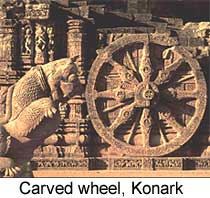 Other recurring themes are rampant mythical beasts, as well as nagas and naginis, each with a human bust, a multi-hooded canopy and a serpent's tail. The chariot wheels are magnificently carved. The hubs and spokes have medallions with miniature deities, erotic and amorous figures, courtiers and hunters. Petalled friezes and scrollwork surround the medallions and cover the circular rims.
Other recurring themes are rampant mythical beasts, as well as nagas and naginis, each with a human bust, a multi-hooded canopy and a serpent's tail. The chariot wheels are magnificently carved. The hubs and spokes have medallions with miniature deities, erotic and amorous figures, courtiers and hunters. Petalled friezes and scrollwork surround the medallions and cover the circular rims.
Little remains of the sanctuary and its tower other than the lower parts of the walls and the mouldings of their basement. The central niches house large green chlorite images of Surya standing in the chariot (south and west) or riding on a spirited horse (north). The precision of the carved details and the subtle facial expression of the god are particularly striking. Subsidiary figures include Aruna the charioteer, two armed attendants, a royal donor and a family priest beneath; goddesses dispelling darkness at the side; and flying celestials above.
In front of these niches are porches reached by double flights of steps, and subsidiary shrines elevated on carved basements, each with three entrances (only the south shrine is partly preserved). Within the principal sanctuary (reached by a descending flight of steps on the west) is an ornate chlorite pedestal, which once supported the image of the presiding deity (vanished). The central niche of this pedestal is carved with a kneeling king, evidently the temple donor, conferring with priests.
The outer walls of the adjoining square mandapa are only incompletely preserved and have been much rebuilt. Large rearing beasts and amorous couples in two tiers are positioned in the niches and recesses. There are also portions of the high and elaborate basement. In the middle of three sides are impressive doorways (preserved fully only on the east, partly on the north), now blocked up. These are carved in chlorite with remarkable detail, especially the hands of foliation, scrollwork, entwined serpents and miniature amorous couples (on the jambs), as well as the seated Navagrahas, musicians and flying celestials (on the linters).
The pyramidal roof rises in three storeys, each with horizontal mouldings. The edges of these mouldings (projecting outwards from the middle of each side) are carved with friezes similar to those on the terrace beneath; upturned medallions at the corners and at other points are filled with miniature animals.
In the two intermediate spaces between the storeys are large freestanding female dancers and musicians; these figures are fully modelled and sensually posed. Multi-headed images of Bhairava are positioned on the east side. Crouching beasts surround the immense amalaka that forms the capping piece of the roof and which rises no less than 38.4 m (126 ft) above the ground; no finial is preserved.
Continue.....



